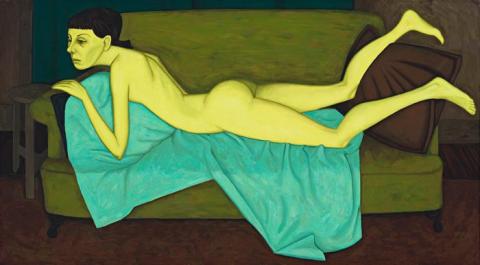THE BOUCHER NUDE, 1957
John Brack
oil on canvas
81.0 x 146.0 cm
signed and dated lower right: John Brack ‘57
Australian Galleries, Melbourne
Mrs V. Macallister, Sydney
Thence by descent
Private collection, NSW
Deutscher~Menzies, Melbourne, 20 April 1998, lot 183
Private collection, Melbourne
Exhibition by John Brack, Australian Galleries, Melbourne, 12 – 29 November 1957, cat. 2
Paintings by Important Australian Artists, Presbyterian Ladies College, Melbourne, March 1958
Helena Rubinstein Travelling Art Scholarship, Art Gallery of New South Wales, August 1958
John Brack, Johnstone Gallery, Brisbane, 26 April –13 May 1960
Australian Painting and Tapestries of the Past 20 Years, New South Wales House, London, May 1972
John Brack, A Retrospective, National Gallery of Victoria, 1987
‘New works add to reputation', The Age, 12 November 1957
McCulloch, A., 'Classical themes', Herald, 13 November 1957
Bonython, K., Modern Australian Painting and Sculpture, Rigby, Adelaide 1960, p. 42
Australian Painting and Tapestries of the Past 20 Years, New South Wales House, London, 1972, pl. 14 (illus.)
Lindsay, R., John Brack: A Retrospective, National Gallery of Victoria, 1987, cat. 38, p. 41
Grishin, S., The Art of John Brack, Oxford University Press, Melbourne 1990, vol. I, pp. 59–60, 102, 120, pl. 8 (illus.) & vol. II, cat. o66, pp. 10 & 102 (illus.)
John Brack's The Boucher Nude, 1957, belongs to a series of nine oil paintings of the nude which the artist first exhibited in Melbourne in November 1957. It was Brack's first excursion into painting of the nude, and the series has subsequently become iconic in Australian art. Other paintings from the series, such as Nude in an armchair, 1957, purchased by the National Gallery of Victoria, and Nude with two chairs, 1957, acquired by the Art Gallery of New South Wales, were both purchased in 1957 directly from Brack's exhibition, Nude on the mattress, 1957, was acquired by the (then) Australian National Gallery in 1969, while The bathroom, 1957, was purchased at auction by the National Gallery of Australia in 1998 for what was at that time a record sum.
The paintings when they were first exhibited were hailed by art critics, and The Age critic noted that they 'will add to the fine reputation already established by Brack'.1 The Age critic singled out for praise The Boucher Nude noting 'The Boucher Nude, for all its dour expression and vivid yellow flesh, must provoke a smile from all who know the extremely saucy, very voluptuous, French work it parodies.'2 Alan McCulloch, writing in The Herald, observed 'in the present series the nude is depersonalised, sexless, slightly satirical and classically architectonic. In Nude in an armchair, The Boucher nude, The empty room, all these and others are seen with clinical detachment. Since Brack's last show, his palette, with its lemon yellows, heliotropes, crimsons and olive greens, has developed a luminosity that adds further pungency to the satire. In thus accepting the challenge of the great traditions Brack risks a lot... but he brings it off.'3
In this series of paintings Brack decided to confront one of the cornerstone traditions of Western art, the classical nude, but to challenge it within a particularly modern context. One unexpected circumstance was the model, the only one who responded to Brack's modest advertisement of 'an artist seeking a model.' She was a middle aged woman, not particularly attractive, of very slender proportions and with short cropped hair, a woman who appeared particularly incongruous and out of place - like a naked housewife - in the artist's somewhat spartan North Balwyn suburban living room. She appeared as such a contrast to the voluptuous and erotic nudes of art history. For Brack it presented a challenge to de-eroticize the nude, to present his artistic invention in the face of audience anticipation. It was also an attempt to achieve a high degree of eloquence through the restraint of sensuousness.
Brack was aware that in art history François Boucher's famous 18th century painting of the nude Marie-Louise O'Murphy, the English youthful mistress of France's King Louis XV, was frequently cited as the most erotic nude ever painted. In his The Boucher Nude Brack retains Boucher's pose - with the model lying on her belly emerging from a sheet draped over a couch, seen side on with legs splayed and her head slightly raised and turned towards the beholder - but he creates the most un-erotic nude in art history. Brack has radically reinterpreted Boucher's artistic convention. It is not so much a question of a contrast between a skinny, awkward, black-haired woman with her small, slightly pinched features and Boucher's plump and sensuous blonde, with her pretty, childish features and rounded proportions; it is more that Brack had engaged his whole repertoire of formal devices deliberately to destroy any trace of sensuousness. The glowing radiance of Boucher's painting is replaced with an acid-yellow flesh tone against a dark green sheet. Brack has presented his naked woman in an austere setting, uncomfortable and unsympathetic, where the naked suburban housewife appears slightly absurd and out-of-place in what is her usual domestic environment. Brack's stark, matter-of-fact presentation pre-empts either a voyeuristic enjoyment of the subject or a misogynist reading.
The Boucher Nude can be justly regarded as one of the great masterpieces in Australian art.
1.'New works add to reputation', Age, 12 November 1957
2. ibid.
3. McCulloch, M., 'Classical themes', Herald, 13 November 1957
PROFESSOR SASHA GRISHIN AM, FAHA THE SIR WILLIAM DOBELL PROFESSOR OF ART HISTORY
AUSTRALIAN NATIONAL UNIVERSITY, CANBERRA
